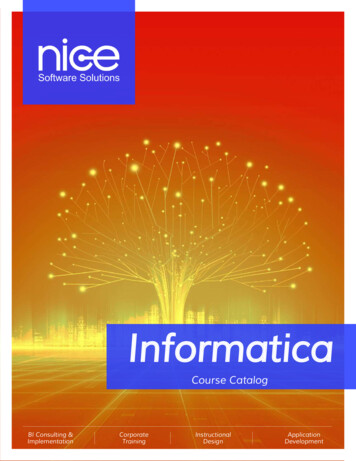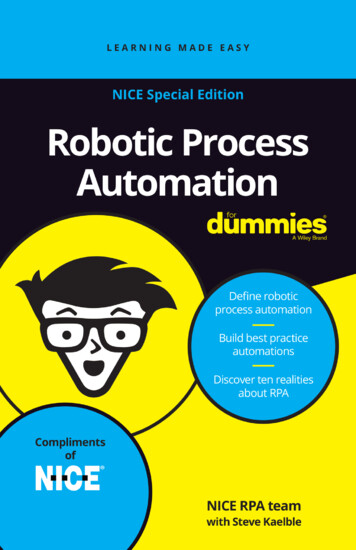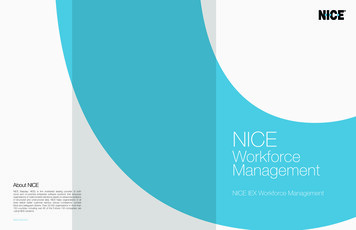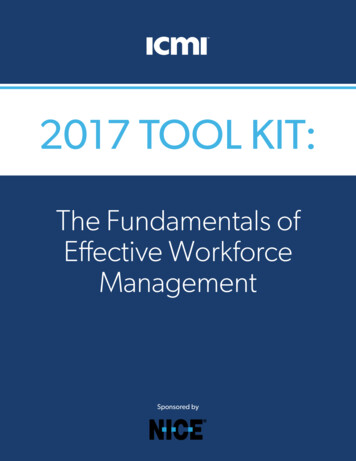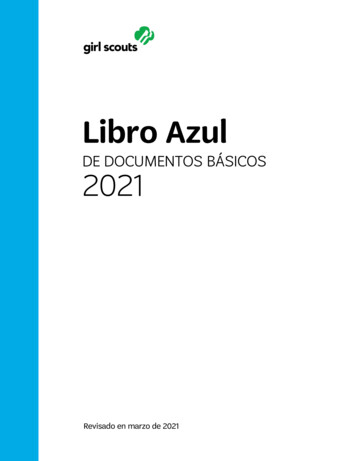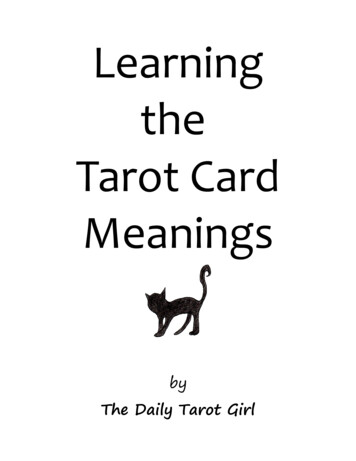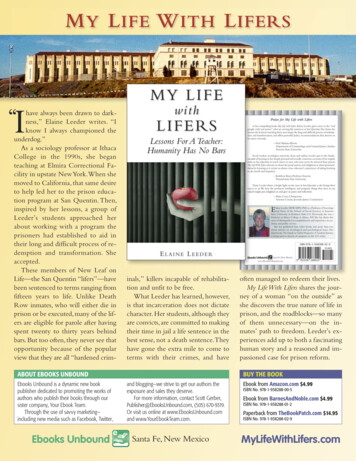
Transcription
M Y L IFE W ITH L IFERS‘‘Ihave always been drawn to darkness,” Elaine Leeder writes. “Iknow I always championed theunderdog.”As a sociology professor at IthacaCollege in the 1990s, she beganteaching at Elmira Correctional Facility in upstate New York.When shemoved to California, that same desireto help led her to the prison education program at San Quentin. Then,inspired by her lessons, a group ofLeeder’s students approached herabout working with a program theprisoners had established to aid intheir long and difficult process of redemption and transformation. Sheaccepted.These members of New Leaf onLife—the San Quentin “lifers”—havebeen sentenced to terms ranging fromfifteen years to life. Unlike DeathRow inmates, who will either die inprison or be executed, many of the lifers are eligible for parole after havingspent twenty to thirty years behindbars. But too often, they never see thatopportunity because of the popularview that they are all “hardened crim-inals,” killers incapable of rehabilitation and unfit to be free.What Leeder has learned, however,is that incarceration does not dictatecharacter. Her students, although theyare convicts, are committed to makingtheir time in jail a life sentence in thebest sense, not a death sentence. Theyhave gone the extra mile to come toterms with their crimes, and haveABOUT EBOOKS UNBOUNDEbooks Unbound is a dynamic new bookpublisher dedicated to promoting the works ofauthors who publish their books through oursister company, Your Ebook Team.Through the use of savvy marketing—including new media such as Facebook, Twitter,often managed to redeem their lives.My Life With Lifers shares the journey of a woman “on the outside” asshe discovers the true nature of life inprison, and the roadblocks—so manyof them unnecessary—on the inmates’ path to freedom. Leeder’s experiences add up to both a fascinatinghuman story and a reasoned and impassioned case for prison reform.BUY THE BOOKand blogging—we strive to get our authors theexposure and sales they deserve.For more information, contact Scott Gerber,Publisher@EbooksUnbound.com, (505) 670-9319.Or visit us online at www.EbooksUnbound.comand www.YourEbookTeam.com.Santa Fe, New MexicoEbook from Amazon.com 4.99ISBN No. 978-1-938288-00-5Ebook from BarnesAndNoble.com 4.99ISBN No. 978-1-938288-01-2Paperback from TheBookPatch.com 14.95ISBN No. 978-1-938288-02-9MyLifeWithLifers.com
I NTRODUCTIONI“I knewsomething waswrong with theway we dealtwith the ‘other.’To me, therewas no ‘other.’”What’s a Nice Girl Like YouDoing in a Place Like This?have always been drawn to darkness and the dark side of people’slives. It may be because my father’s family was killed in Lithuaniaduring the Holocaust; it might also bebecause my mother’s people were immigrants from Poland, with many ofthe troubles that immigrant familiesexperienced, including poverty andmental illness.My childhood home always hadthe shades drawn so the neighborswould not see what was going on inside. In my father’s village in Lithuania,it was the neighbors who turned in theJews and watched them beingmarched off to the pits where my family was shot and buried. My fatherspent his whole life remembering hisdead mother, sister, and brother, andfeeling survivor’s guilt for having madeit out alive before the war began.Money had been sent for onefamily member to travel to the U.S.His sister was to go, but she decidedto stay home to care for their elderlyfather. My own father was sent instead, with plans to pay the way for therest of the family when he raised themoney. But Hitler marched throughEastern Europe first, slaughtering millions. My family was among them. Myfather’s faith in God was his only solace through tormented days andnights. He often sat late into the nightreading Jewish religious tracts seekingthe peace he could not find otherwise.Whatever the cause of my beingdrawn to darkness, I know I alwayschampioned the underdog. In the firstgrade, a young African-Americanfriend called for me on the second dayof school, but my mother told me Icould not walk with her or be herfriend. I knew something was wrongwith the way we dealt with the“other.” To me, there was no “other”—she was my friend, and I wouldspend time with her, no matter whatI was told.This rebellion stayed with methrough childhood, college, and laterlife. By the time I was in college, I hadmarched with Martin Luther Kingbefore his famous “I Have a Dream”speech. In Boston, where I went toschool, there was a rich tradition of rebellion, and it was easy for me to findit. I smoked pot before it was “in,” be-Excerpted from My Life With Lifers. Copyright 2012 Ebooks Unbound–1–“By the timeI was incollege, I hadmarched withMartin LutherKing before hisfamous ‘I Havea Dream’speech.”
“In thesegroups, Idiscovered thatas a woman ina patriarchalsociety, I, too,was anunderdog.”ginning as early as 1965. I joined civilrights and antiwar activities, and I wasin a feminist consciousness-raisinggroup as soon as such movementsemerged. In these groups, I discoveredthat as a woman in a patriarchal society, I, too, was an underdog.When I saw that I was discriminated against as a woman, I began toidentify my dissatisfaction with theway things were in our society; I wastormented by social inequality, genderdiscrimination, class bias, racism, andmilitarism.Having been raised an orthodoxJew, I knew about “doing good” inthe world; it was part of a Jewishworld view.These deeply instilled values taught me to love all human beings, to give charity, to wrong no one,to help a neighbor, to never take revenge, to embrace the stranger amongus, to work for justice in the world,and to repair the “tear” in the universeby being a good human being. Thesevalues are called mitzvoth, part of the613 commandments that Jews are supposed to follow. I might not have followed the religious rituals all my life,but they have governed my behavioras much as possible.As a social worker in New YorkCity, a therapist at mental hospitals andmental health clinics, and while working with alcoholics and drug addicts, Iwas fascinated by people who did notfit the norm. I always wondered howthey could do it, since I tended to besomeone who could not do muchthat was illegal. After many years ofeducation and training, I became acollege professor. I began to study deviance and its complexity, wanting tounderstand what drove people to doharm to others. At first, I began working with victims of domestic violence,but I was soon drawn to the perpetrators, to the challenge of their complicated minds. As a feminist, I felt it wasmy social obligation to work withpeople who caused pain to women.While working in a summer programfor students about to enter college,some of them asked to visit a prison.I, too, was interested in such places,knowing that people there could helpme understand perpetrators of domestic violence.In 1995, in what was to be a pivotal moment in my career, I took thehigh school students to the ElmiraCorrectional Facility in upstate NewYork for a tour by the warden. I wasstruck by the cold, harsh facility andthe fact that it was 150 years old.When the tour was over, I asked thewarden if the inmates had any educational opportunities. He said they hadonly GED classes and some self-helpprograms like Alcoholics Anonymous(A.A.). In an impetuous moment ofgenerosity, I offered to bring somecollege education programs inside.The warden was thrilled, and thusbegan my career with prisoners.Several years later when I movedto California to become the dean ofsocial sciences at Sonoma State University, I discovered a prison educationprogram at San Quentin State Prison.Drawn once again to the dark side, Ibegan volunteering there and wasonce again taken with the work because it was so gripping to find humanconnection in such a dark and miserable place.When the class ended, a few prisoners who were my students asked if IExcerpted from My Life With Lifers. Copyright 2012 Ebooks Unbound–2–“I discovereda prisoneducationprogram at SanQuentin StatePrison . . .I beganvolunteeringthere and wasonce againtaken with thework because itwas so grippingto find humanconnection insuch a darkand miserableplace.”
“In California,it costs 46,000 a yearto incarceratea prisoner.Certainly, thismoney couldbe better spentelsewhere thanfor these menwho no longerneed to bethere.”would lead a group of lifers. I was flattered that they thought enough of meto have our own group. New Leaf onLife, a name chosen by the prisonersthemselves, has continued since its inception in 2005. These men were sentenced to life in prison—with thepossibility of parole—not to death inprison. And yet there they stay becauseof the attitudes and prejudices againstthem. Having paid their dues to society,most pose no risk to that society anymore, and many guards, educators, andadministrators in prisons agree thatthey should be out. In California, itcosts 46,000 a year to incarcerate aprisoner. Certainly, this money couldbe better spent elsewhere than for thesemen who no longer need to be there.I am not writing here about thosewho are unable or unwilling to change,nor those who will continue to pose arisk to society. But they are the minority among those who are in for “life.”Yet social policy often focuses on theyoung “gang bangers” who are doingshort sentences, or on death row inmates who will never get out.The experience in prison has setme on a new path of work. I havelearned much from my students, perhaps even more than they gained fromme. In this book, I share these lessonsI have learned as I watch men insidebegin the long and difficult process ofredemption and transformation.In my fifteen years’ work in majorprisons, I have spent much time in thedarkness of life there, and I have seenmany inmates come into the light asthe process of change occurs. Manypeople have asked me details of mywork with prisoners; thus, I have decided to document my experiencesand highlight some of the men withwhom I have had the privilege ofworking. Most of these men havecommitted terrible crimes, crimes forwhich they have been sentenced tolong terms. Many have served at leastthe minimum necessary for parole, butstill they remain in prison because ofthe nature of parole and “get tough oncrime” views that make it impossiblefor men who are ready to be releasedto begin life outside.Public policy and social change efforts need to distinguish amonggroups of prisoners and see that theycannot be generalized; each categoryhas its own risks, challenges, and policy issues.How many of us outside drive byprisons rarely thinking of the warehousing of humanity taking place behind those walls? Before I went into aprison, I thought everyone there deserved to be there—they belonged inside; the experience of prison wasgood for them, punishing them forwhat they had done. Once inside, Ihave learned about the real people,with real stories and reasons for doingwhat they did.In this book, I will tell you someof these stories, since every one is different. Though they have committedterrible crimes, these are not evil people. For the most part, they are awareof and disturbed by what they did. Ihave learned that each one has a family traumatized by his crimes, as thevictims and their families have been.Most are remorseful for what they did,and often want to make amends to thevictims, their families, and the community they have harmed.These are thoughts often not con-Excerpted from My Life With Lifers. Copyright 2012 Ebooks Unbound–3–“In this book,I will tell yousome of thesestories, sinceevery one isdifferent.Though theyhave committedterrible crimes,these are notevil people. ”
“I also havelearned there islittle to norehabilitation inprisons, andthat if aprisoner is totransform, it isdone throughsheer grit anddetermination—succeeding inspite of thesystem, notbecause of it.”veyed to the larger society, whichwatches “Lockup” and thinks everyone inside is a predator, and that violence is a daily experience in prisonlife. Many in our society enjoy seeingothers suffer; thus, we watch suchshows catering to our prurient interests. Just remember how we were allglued to the television during the9/11 attacks, watching people jumpfrom the burning towers. Often, wethink no further about such showsafter we turn off the TV. Now, I havelearned that there is more to whatgoes on in prison than is covered bymovies and TV.I also have learned there is little tono rehabilitation in prisons, and that ifa prisoner is to transform, it is donethrough sheer grit and determination—succeeding in spite of the system, not because of it. I have learnedthat people who commit crimes canchange, and that many of them coulddo more good on the outside workingwith young people. These men wereonce directionless kids in gangs, oftenin trouble. Sure, there are inmates Iwould never want to see on thestreets, but they are the minority. Infact, the U.S. Department of Justice estimates that 95 percent of those whoare incarcerated will be eventually discharged. Therefore, it is imperative asa society that we do something forthese prisoners so they can becomecontributing members of our world.In the following pages, I will tellyou about my experiences inside prisons and what I have learned workingwith this population, as well as suggestsome policy changes that are badlyneeded. Having taught sociology formany years, I know about social prob-lems from the inside out.The mass incarceration we in theU.S. are living with now, particularly ofpeople of color, can be considered thenewest form of slavery. Angela Davisargues in her book Are Prisons Obsolete? (Seven Stories Press, 2003) thatthis incarceration binge is a contemporary manifestation of the racializeddisparities that many of us believe wereabolished in 1865. In fact, more blackmen are in prison now than livedunder slavery. From 1990 to 2003,African-Americans made up the majority of the increase in incarceration,with the number of imprisoned blacksjumping 76.2 percent from 360,000 to621,000 (Wright J., 2006). Now, 3.5percent of all black males are in prison,and more than 10 percent in the 2529 age group (p. 316). More black menare in prison than attending college.This increase is in stark contrast to thefact that the numbers of violent crimesis decreasing at the same time!In the U.S. today, there is a movement toward decarceration. The prisoner rights movement is advocatingalternatives to incarceration—restorative justice and reconciliation ratherthan building more prisons. It seemsundeniable that economic and racialdisparities are major contributors tocrime, that lack of opportunity leadspeople to meet their needs illegally.Wecould take major steps toward decarceration and its many benefits if oursociety sought solutions to povertyand an end to both the gross inequalities in our public education systemand the criminalization of drugs. Myexperiences with men in prison havetaught me that change is possible.Here is my story and theirs.Excerpted from My Life With Lifers. Copyright 2012 Ebooks Unbound–4–“We could takemajor stepstowarddecarcerationand its manybenefits if oursociety soughtsolutions topoverty and anend to both thegrossinequalities inour publiceducationsystem and thecriminalizationof drugs. ”
PRESS RELEASEContact: Scott Gerber Publisher@EbooksUnbound.com (505) 670-9319ebooksunboundNew works for a new eraEbooksUnbound.com33 Alondra Road,Santa Fe, NM 87508(505) 670-9319ElaineLeeder’slatest book,My LifeWith Lifers,combines afascinatinghuman storywith areasoned butimpassionedcall for prisonreform.FORMIM EDIATERELEASEAPRIL 5, 2012My Life With Lifers, by Elaine LeederEbook tells educator’s story of redemption behind bars,and of a society blinded by denial and revengeBook publisher Ebooks Unbound releases the latest book by Sonoma State UniversityDean of Social Sciences Elaine Leeder. My Life With Lifers: Lessons for a Teacher—Humanity Has No Bars is a memoir of Dr. Leeder’s experiences teaching men servinglife sentences at San Quentin State Prison in California. In telling her fascinating humanstory, Dr. Leeder also makes a reasoned but impassioned case for prison reform.“I have always been drawn to darkness,” Elaine Leeder writes. “I know I have alwayschampioned the underdog.” At San Quentin, she learned that incarceration does notdictate character. Her students, although they are convicts, are committed to makingtheir time in jail a life sentence in the best sense, not a death sentence. My Life WithLifers shares the journey of a woman “on the outside” as she discovers the truecharacter of life in jail, and the roadblocks—so many of them unnecessary—on theinmates’ path to freedom.Author, activist, and educator Elaine Leeder is committed to shifting the United States’prison policies from an atmosphere of fear and revenge to one of rehabilitation.Dr. Leeder currently serves as Dean of Social Sciences at Sonoma State University inCalifornia, and has authored more than two dozen articles on sociological andpsychological issues. Her previous books include The Gentle General: Rose Pesotta,Anarchist and Labor Organizer (1993); Treating Abuse in Families: A Feminist andCommunity Approach (1994); The Family in Global Perspective: A Gendered Journey(2003); and Inside and Out: Women, Prison, and Therapy (2006).My Life With Lifers: Lessons for a Teacher—Humanity Has No Bars is available forKindle and Nook, on PCs through free Kindle and Nook apps, and in paperback. Formore information on Elaine Leeder and her work, visit www.MyLifeWithLifers.com.Founded in 2012, Ebooks Unbound publishes the best writers seeking to publish theirmanuscripts as ebooks. In a world where the internet makes manuscript publishingand distribution an increasingly accessible goal, more and more contemporary authorsseek to take control of their creative efforts. With more than 45 years’ experience inediting, publishing, and marketing, we provide the services that authors require—allwhile keeping the authors’ visions at the forefront of our goals. For more informationon our services and dynamic business model, please visit www.EbooksUnbound.com.
ThePressDemocratSATURDAY, JANUARY 30, 2010Reprinted from www.PressDemocrat.comSANTA ROSA, CALIFORNIAMy life among the lifers atSan Quentin prisonBy Elaine LeederAs I walk through the iron doors, gatesbanging behind me, I often feel like I am entering a foreign world. It is a world I amslowly learning about, but I always seem tohave to learn more, every time I enter.For the past nine years, I have been running groups for "lifers" at San Quentin StatePrison. These are men, sentenced to 15 yearsto life for first- and second-degree murder orattempted murder, who after spending atleast 20 or 30 years behind bars are eligiblefor parole. There are some 10,000 of themamong the 167,000 inmates in the Californiaprison system.The guys in my group at San Quentinmight be called "hardened criminals" and notworthy of parole. My experience has taughtme otherwise.These are felons who have gone the extramile to come to terms with their crimes, whohave redeemed their lives and are ready tojoin society, having worked hard to changetheir lives.Yet many have been denied release by theparole board or the governor. They differfrom Death Row prisoners, who will die inprison or be executed.My group is for lifers who are interestedin this kind of self-help program. It is selfselecting and inmate-run. I am the sponsor,along with another private citizen and oneprison employee.My first experience in prison was teaching a class at Elmira Correctional Facility inupstate New York, where inmates were givencredit for the sociology class I taught throughIthaca College. When I moved to California,I heard about the Patten University Program,which grants community college credit toprisoners at San Quentin through volunteerteaching on the part of faculty from all overthe Bay Area.After teaching for them, I was asked bysome of the guys to run our own group, pris-Elaine Leederoner-initiated and
for students about to enter college, some of them asked to visit a prison. I, too, was interested in such places, knowing that people there could help me understand perpetrators of domes-tic violence. In 1995, in what was to be a piv-otal moment in my career, I took the high school students to the
